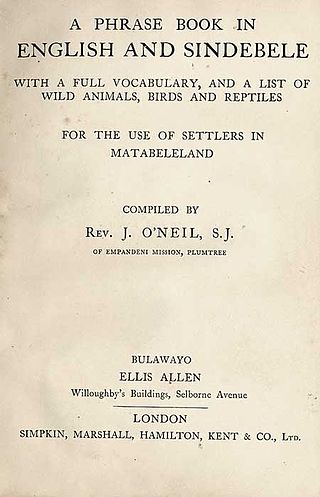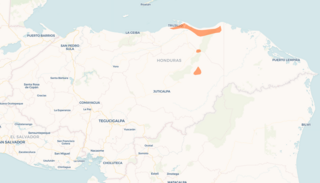Related Research Articles

The Oto-Manguean or Otomanguean languages are a large family comprising several subfamilies of indigenous languages of the Americas. All of the Oto-Manguean languages that are now spoken are indigenous to Mexico, but the Manguean branch of the family, which is now extinct, was spoken as far south as Nicaragua and Costa Rica. Oto-Manguean is widely viewed as a proven language family.
Temne is a language of the Mel branch of the Niger–Congo language family. Temne speakers live mostly in the Northern Province and Western Area, Sierra Leone. Temne people can be found in a number of other West African countries as well, including Guinea and The Gambia. Some Temnes have also migrated beyond West Africa seeking educational and professional opportunities, especially in Great Britain, the United States, and Egypt.

Northern Ndebele, also called Ndebele, isiNdebele saseNyakatho, Zimbabwean Ndebele or North Ndebele, associated with the term Matabele, is a Bantu language spoken by the Northern Ndebele people which belongs to the Nguni group of languages.

Ume Sámi is a Sámi language spoken in Sweden and formerly in Norway. It is a moribund language with an estimated 100 speakers. It was spoken mainly along the Ume River in the south of present-day Arjeplog, in Sorsele and in Arvidsjaur.
Tonga (Chitonga), also known as Zambezi, is a Bantu language primarily spoken by the Tonga people who live mainly in the Southern province, Lusaka province, Central Province and Western province of Zambia, and in northern Zimbabwe, with a few in northwest Mozambique. The language is also spoken by the Iwe, Toka and Leya people among others, as well as many bilingual Zambians and Zimbabweans. In Zambia Tonga is taught in schools as first language in the whole of Southern Province, Lusaka and Central Provinces.

Bontoc (Bontok) is the native language of the indigenous Bontoc people of the Mountain Province, in the northern part of the Philippines.
Guéré (Gere), also called Wè (Wee), is a Kru language spoken by over 300,000 people in the Dix-Huit Montagnes and Moyen-Cavally regions of Ivory Coast.
Maninka, or more precisely Eastern Maninka, is the name of several closely related languages and dialects of the southeastern Manding subgroup of the Mande language family. It is the mother tongue of the Malinké people in Guinea, where it is spoken by 3.1 million people and is the main language in the Upper Guinea region, and in Mali, where the closely related Bambara is a national language, as well as in Liberia, Senegal, Sierra Leone and Ivory Coast, where it has no official status. It was the language of court and government during the Mali Empire.

The Tarahumara language is a Mexican Indigenous language of the Uto-Aztecan language family spoken by around 70,000 Tarahumara (Rarámuri/Ralámuli) people in the state of Chihuahua, according to a 2002 census conducted by the government of Mexico.

The Tati language is a Northwestern Iranian language spoken by the Tat people of Iran which is closely related to other languages such as Talysh, Zaza, Mazandarani and Gilaki.
Iau or Turu is a Lakes Plain language of West Papua, Indonesia, spoken by about 2,100 people, native speakers of this language are the Turu people (Iau). Most speakers are monolingual, and their number is growing. Other peoples in the western Lakes Plain area speak basic Iau. Iau is heavily tonal, with 11 tones on nouns and 19 simple and compound tones on verbs.

The Kissi people are a West African ethnolinguistic group. They are the fourth largest ethnic group in Guinea, making up 6.2% of the population. Kissi people are also found in Liberia and Sierra Leone. They speak the Kissi language, which belongs to the Mel branch of the Niger–Congo language family. The Kissi are well known for making baskets and weaving on vertical looms. In past times, they were also famous for their ironworking skills, as the country and its neighbors possessed rich iron deposits. Kissi smiths produced the famous "Kissi penny,"
The Bullom languages are a small group of Mel languages spoken in Sierra Leone, including along the Bullom Shore. They were historically sometimes referred to as one language or dialect continuum, divided into Southern Bullom and Northern Bullom. The languages are:

Pech or Pesh is a Chibchan language spoken in Honduras. It was formerly known as Paya, and continues to be referred to in this manner by several sources, though there are negative connotations associated with this term. It has also been referred to as Seco. There are 300 speakers according to Yasugi (2007). It is spoken near the north-central coast of Honduras, in the Dulce Nombre de Culmí municipality of Olancho Department.
Gola is a language of Liberia and Sierra Leone. It was traditionally classified as an Atlantic language, but this is no longer accepted in more recent studies.
The Tedim language is a Tibeto-Burman language spoken mostly in the southern Indo-Burmese border. It is the native language of the Tedim tribe of the Zomi people, and a form of standardized dialect merging from the Sukte and Kamhau dialects. It is a subject-object verb language, and negation follows the verb. It is mutually intelligible with the Paite language.
Afenmai (Afemai), Yekhee, or Iyekhe, is an Edoid language spoken in Edo State, Nigeria by Afenmai people. Not all speakers recognize the name Yekhee; some use the district name Etsako.

Ute is a dialect of the Colorado River Numic language, spoken by the Ute people. Speakers primarily live on three reservations: Uintah-Ouray in northeastern Utah, Southern Ute in southwestern Colorado, and Ute Mountain in southwestern Colorado and southeastern Utah. Ute is part of the Numic branch of the Uto-Aztecan language family. Other dialects in this dialect chain are Chemehuevi and Southern Paiute. As of 2010, there were 1,640 speakers combined of all three dialects Colorado River Numic. Ute's parent language, Colorado River Numic, is classified as a threatened language, although there are tribally-sponsored language revitalization programs for the dialect.
Mmen (Bafmeng) is a Grassfields Bantu language of Cameroon.
Highland Chinantec is a Chinantecan language of Mexico, spoken in Comaltepec, San Juan Quiotepec, and surrounding towns in northern Oaxaca. It has a complex system of tone and vowel length compared to other Chinantec languages. The two principal varieties, Quiotepec and Comaltepec, have marginal mutual intelligibility. Yolox Chinantec is somewhat less divergent.
References
- ↑ Southern Kissi at Ethnologue (25th ed., 2022)

Northern Kissi at Ethnologue (25th ed., 2022)
- 1 2 Childs, G. Tucker (1995-01-01). A Grammar of Kisi: A Southern Atlantic Language. Walter de Gruyter. ISBN 9783110810882.
- G. Tucker Childs. A Grammar of Kisi, A Southern Atlantic Language. 1995. 370 pp.
- G. Tucker Childs: A Dictionary of the Kisi Language. With an English-Kisi Index
- Denise Paulme. Les Gens du Riz: Les Kissi de Haute-Guinée. Paris. Librairie Plon. 1954, 1970. 324 pp. Online version